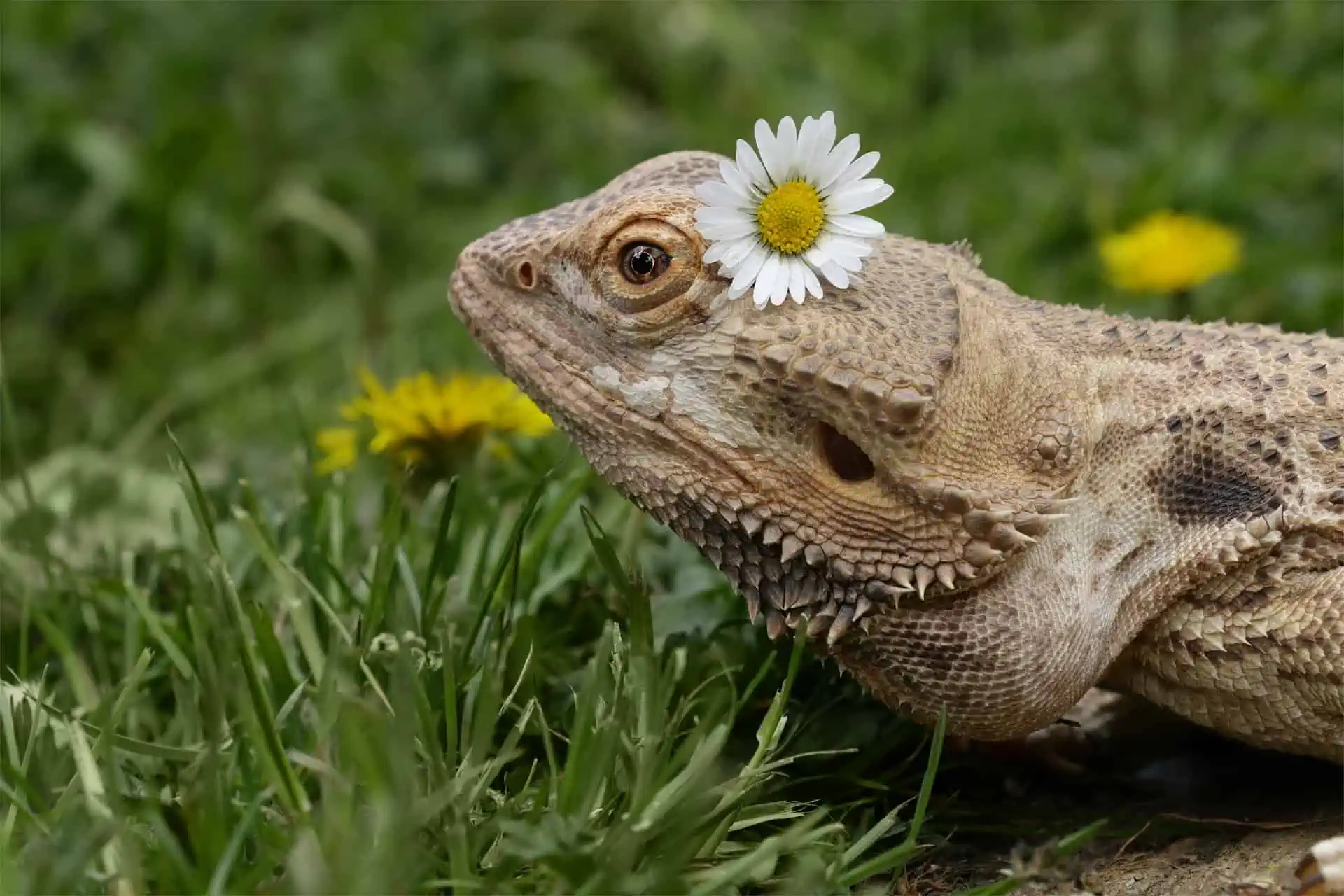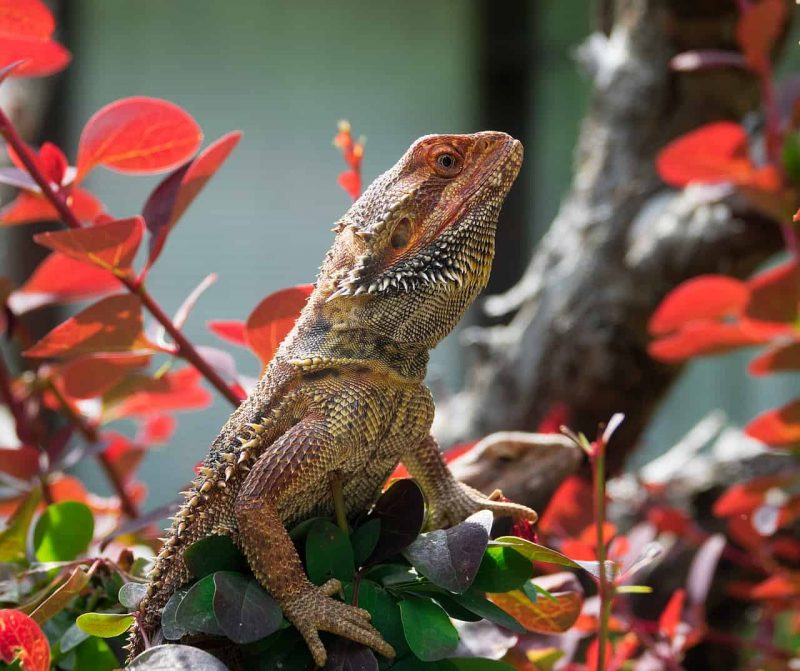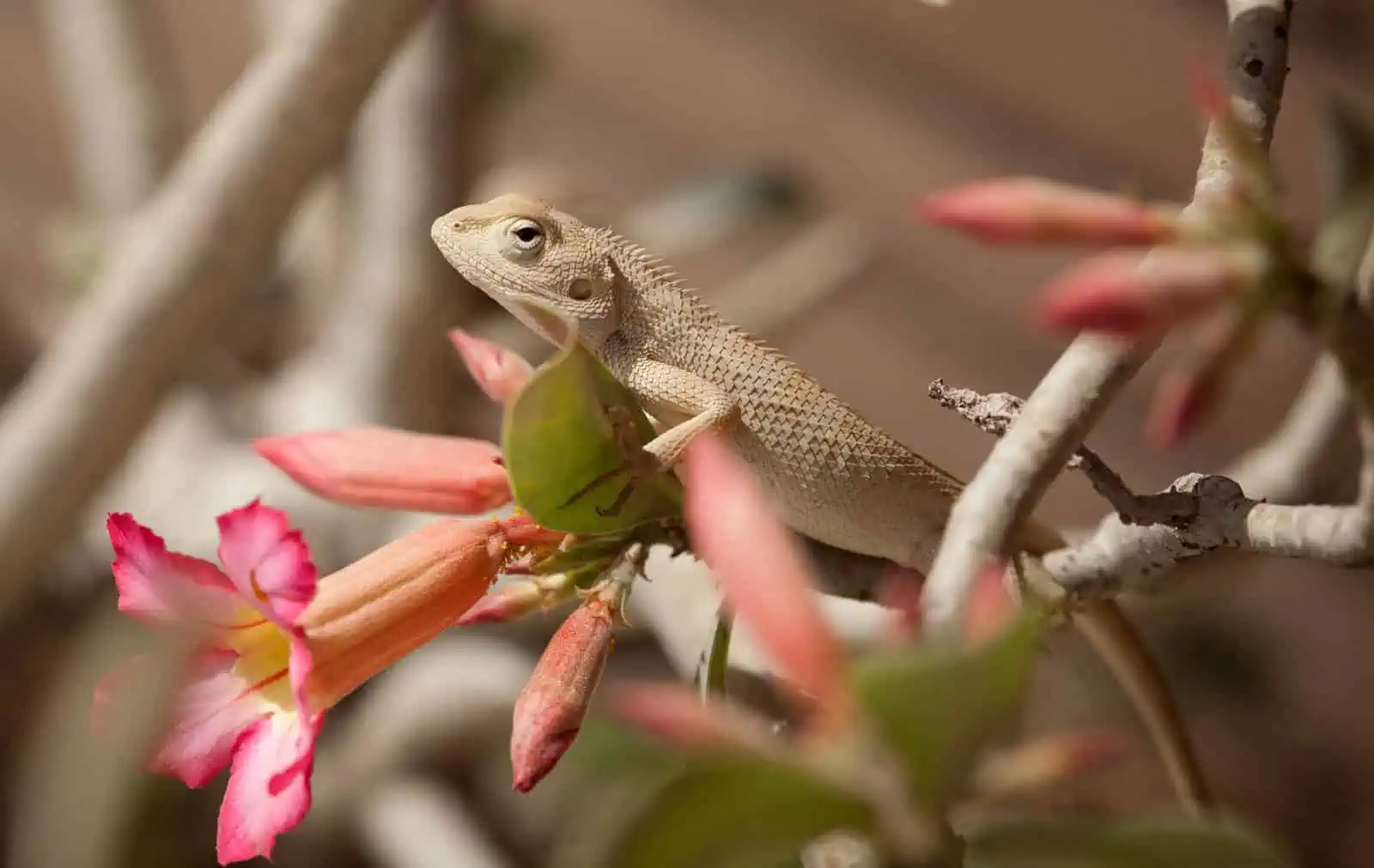Are you a bearded dragon owner who wants to take your pet’s enclosure to the next level? When you are a new bearded dragon owner, it makes sense to keep things simple until you gain more experience caring for your beardie.
When you have gained experience, you can enrich your beardie’s world by enhancing its enclosure with plants. However, before you start adding plants to your pet’s home, there are some important things you need to think about.
Have you cared for plants before? Do you have the time to take care of the plants and your bearded dragon? Do you know which plants are safe to keep with your pet and which may be toxic? In this article, you will learn how to choose the right plants for your bearded dragon.
Importance of Choosing the Right Plants for Your Bearded Dragon Enclosure
When choosing plants for your bearded dragon’s enclosure, it is important to consider its maintenance requirements and if it is safe for your pet. Different plants have different lighting, temperature, and humidity requirements. Also, some plants may be toxic to your pet.
Benefits of Including Plants in Your Bearded Dragon’s Enclosure
If you grow live plants in your bearded dragon enclosure, you create a bioactive enclosure. You are creating an environment that more closely replicates your lizard’s ecosystem. Doing this will add additional stimulation that will provide enrichment for your pet.
Risks of Including the Wrong Plants
It is important to know which plants to use in the enclosure. Bearded dragons are curious about nature and may take a bite of potentially toxic plants. Some plants have flowers or leaves that are poisonous. In some species, the entire plant is toxic.
Can You Keep Live Plants in the Bearded Dragon Tank?
Live plants can be kept in your bearded dragon tank as long as they are safe. It is recommended that you keep them in terracotta pots, which will help stabilize the plants. If you decide to make the tank bioactive, you will need to consider the substrate you use.
For bioactive enclosures, you can use a mixture of fine sand (50%), topsoil (30%), and clay soil (20%). Also, make sure that you choose plants that will thrive in the enclosure’s temperature, lighting, and humidity parameters. After planting your plants, mist them. Doing this may temporarily raise the humidity but will return to normal.
Pros and Cons of Live Plants
Keeping live plants in your beardie’s enclosure has pros and cons:
The Pros
- Live plants will provide more stimulation for your pet than artificial plants, given their texture and scent.
- Different species of plants require different levels of maintenance. Because of this, you will not significantly increase the amount of work needed to maintain the enclosure if you choose low-maintenance species.
- Choosing a safe plant for your beardie’s enclosure can also provide variety to its diet. As they do in the wild, your beardie will be able to nibble on the leaves.
The Cons
The disadvantages of using live plants include the following:
- Some plant species may require a lot of maintenance as they may overtake the tank.
- Live plants take more work than keeping artificial plants.
- Some live plants are toxic.
15 Safe Plants for Bearded Dragon Enclosure
When selecting plants, you want to choose species that are not only safe for your bearded dragon to eat but also will do well in a terrarium. The following are suggestions:
Haworthia Plant (Haworithia)
Given that it is from South Africa’s deserts, the Hawortia plant is a great choice for bearded dragons. This plant will do well with the temperature and humidity parameters that bearded dragons need.
Two species, in particular, are worth considering, Haworthia reinwardtii and Haworthia cooperi. The Haworthia plant requires low maintenance, and they do not grow large.
Echeveria (Echeveria)
Like the Haworthia plant, echeveria is another plant that grows in arid regions but is found in the Americas. There are 150 subspecies of this plant, and there are hybrids as well, so there are numerous varieties to choose from.
Prickly Pear Cacti (Opuntia)
Another plant from America’s arid regions, the prickly pear cactus, has been used by humans as food and in desert landscaping. The prickly pear cacti will do well in the climate parameters of your pet’s enclosure. However, they do have some drawbacks. These plants have spines, and you will have to prune the cacti to keep them from growing too large.
Aloe Plants (Aloe vera)
The aloe vera plant makes an ideal addition to a bearded dragon’s enclosure. Besides their medicinal properties, these plants do well in arid conditions. There are many species of aloe vera, and some can grow quite large. If you are interested in getting an aloe vera, I recommend you find out what the adult size of the species is that is being sold.
Dwarf Jade Plants (Portulacaria afra)
Native to eastern South Africa, the dwarf jade plant is found in arid and rocky regions. This species is actually a small tree, so pruning would be needed to keep it from growing too large. The dwarf jade plant is similar in appearance to the jade plant (Crassula ovata), which is mildly toxic.
Basil (Ocimum basilicum)
Often used as a cooking herb, basil is another good choice for the bearded dragon enclosure. While basil grows best outdoors, it will grow indoors if provided with bright lighting and the proper care. The disadvantage of using basil is that bearded dragons may find it too appetizing, so the plant may have difficulty growing.
Parsley (Petroselinum crispum)
Another common cooking herb, parsley, will do well in the bearded dragon enclosure. As with basil, it needs bright light to thrive. Besides being edible, parsley is also nutritious.
Oregano (Origanum vulgare)
Oregano is another commonly used cooking herb that is suitable for a beardie enclosure. However, the plant will most likely serve to make the enclosure look more natural than providing a food source for your pet. Beaded dragons tend not to show much interest in this plant. These plants do best in pots as they need to be kept moist.
Hoya australis (Hoya australis)
Hoya australis is a natural choice for the bearded dragon enclosure as it is found in Australia! The one disadvantage of this plant is that it is a vine that is fast-growing. For this reason, it will require regular pruning.
Ficus (Ficus)
Ficus is a small tree species that does well indoors. If you choose to go with ficus, I recommend putting them in a pot, as gravel or sand will not support them. Also, ficus needs bright lighting. Bearded dragons tend not to show interest in ficus, so this plant would mainly serve to add a natural look to the enclosure.
Leatherleaf Sedge (Carex buchananii)
The leatherleaf sage is an excellent grass for the bearded dragon enclosure as it thrives in arid conditions. Bearded dragons will enjoy eating it, but you will need to trim it regularly to keep it from spreading.
Bolivian Wandering Jew (Callisia repens)
The Bolivian Wandering Jew will provide thick foliage in the enclosure. However, there are two things to consider. First, this plant requires moist soil, so it should be placed in a pot rather than planted in the enclosure’s substrate. Also, they require frequent pruning.
Nasturtium (Tropaeolum)
With its colorful flowers and trailing tendrils, the nasturtium is hardy and fast-growing. It can be used as a backdrop and serve as food. This plant will continue to thrive, even when your bearded dragon nibbles on it.
Bromeliad (Bromeliacease)
Bromeliad is another colorful plant that will thrive in your bearded dragon’s enclosure. Also, it requires minimal sunlight and water. The bromeliad is in the same family as the pineapple, having the same growth pattern in its leaves. Because of their tough structure, they can withstand having your beardie take bites out of them.
Ponytail Palm (Beaucarnea recurvata)
Named for the long thin leaves that sprout from its trunk, the ponytail palm is a succulent, not a tree. As this plant stores water, it will do well in arid conditions with minimal watering. The ponytail palm does not require regular sunlight. However, the ultraviolet light of the enclosure may cause its growth to accelerate. For this reason, it may need pruning.
How Often Should I Replace the Plants in My Bearded Dragon’s Enclosure?
Plants should be replaced when they do not seem to be thriving or create a problem in maintaining the enclosure. You may also want to replace plants to try a different species to see how your beardie responds to it. Beardie may favor some plant species over others.
Can You Use Artificial Plants in Your Bearded Dragon’s Habitat?
Artificial plants are a good choice, especially for those new to keeping bearded dragons. Artificial plants require very little maintenance. Artificial plants made of silk or fabric will be more difficult to clean, and they may have been treated with chemicals that may be harmful to your pet.
To be on the safe side, choose aquarium-grade artificial plants or ones from recognized brands. Doing so will assure you that they are safe for your beardie.
You can also provide a mixture of artificial and real plants, such as using artificial vines as a backdrop in the enclosure and using real plants in front of the enclosure.
Plants to Avoid
When it comes to plant toxicity and bearded dragons, it is best to be over-cautious rather than sorry. I say this because there are plants that may be toxic to bearded dragons. These plant species may have parts that are toxic, or the entire plant is dangerous. To protect your bearded dragon’s health, avoid the following plant species:
- Acokanthera (Acokanthera)
- Amaryllis (Amaryllis)
- Angel’s Trumpet (Datura)
- Apple (Malus)
- Avocado (Persea americana)
- Azalea (Rhododendron canadenis)
- Baneberry (Actaea)
- Belladonna (Atropa belladonna)
- Bird of Paradise (Poinciana)
- Bitter Melon (Momordica charantia)
- Bittersweet (Celastrus)
- Black Locust (Robinia pseudoacacia)
- Boxwood (Boxus)
- Braken Fern (Pteridium aquilinum)
- Buckthorn (Karwinskia)
- Burdock (Arctium)
- Buttercup (Ranunculus)
- Caladium (Caladium)
- Calla Lily (Zantedeschia aethiopica)
- Catclaw Acacia (Acacia greggii)
- Castor Bean (Ricinus communis)
- Cherry (Prunus)
- Chinaberry (Melia azedarach)
- Clematis (Clematis)
- Coral Plant (Jatropha mutifida)
- Crocus (Cholochicum autumnale)
- Cycad (Cycas revoluta)
- Daffodil (Narcissus tazetta)
- Daphne (Daphne mezerum)
- Death Camas (Zigadenus)
- Delphinium (Delphinium)
- Devil’s Ivy (Epipremnum aureum)
- Dieffenbachia (Dieffenbachia)
- Eggplant (Solonum melongena)
- Elderberry (Sambucus Mexicana)
- English Ivy (Hedera)
- Euonymus (Euonymus)
- Pennyroyal (Mentha pulegium)
- Four o’clock (Mirabilis jalapa)
- Heliotrope (Heliotropium)
- Henbane (Hyoscyamus niger)
- Holly (Ilex)
- Horse Chestnut (Aesculus)
- Horse Nettle (Solanum carolinense)
- Hyacinth (Hyacinthus orientalis)
- Hydrangea (Hydrangea)
- Iris (Iris)
- Jack-in-the-Pulpit (Arisaema)
- Jerusalem Cherry (Solanum)
- Jonquil (Narcissus jonquilla)
- Juniper (Juniperus)
- Lantana (Lantana camara)
- Larkspur (Delphinium)
- Laurel (Kalmia)
- Lily-of-the-Valley (Convalleria majalis)
- Lobelia (Lobelia)
- Locoweed (Astragalus)
- Lupine (Lupinus)
- Marijuana (Cannabis)
- Milkweed (Asclepias)
- Mistletoe (Phoradendron villosum)
- Mock Orange (Philadelphus)
- Moonseed (Menispermum canadense)
- Monkshood (Aconitum)
- Morning Glory (Ipomoea violacea)
- Narcissus (Narcissus)
- Oleander (Nerium oleander)
- Oxytopis (Oxytopis)
- Peach (Prunus persica)
- Peony (Paeonia officinalis)
- Periwinkle (Vinca)
- Peyote (Lophophora williamsii)
- Philodendron (Philodendron)
- Plum (Prunus)
- Poison Hemlock (Conium maculatum)
- Poison Ivy/Oak/Sumac (Toxicodendron)
- Poinsettia (Euphorbia pulcherrima)
- Poppy (Papaver)
- Pokeweed (Phytolacca americana)
- Potato (Solanum tuberosum)
- Pothos (Eprimemnum aureum)
- Primrose (Prmula)
- Privet (Ligustrum vulgare)
- Ragwort (Senecio)
- Rhododendron (Rhododendron)
- Rhubarb (Rheum rhabarbarum)
- Rosary Pea (Abrus precatorius)
- Sage (Salvia officinalis)
- Shamrock Plant (Medicago lupulina)
- Skunk Cabbage (Symplocarpus foetidus)
- Snowdrop (Galanthus nivalis)
- Sorrel (Rumex)
- Spurges (Euphorbia)
- Star of Bethlehem (Ornithogalum umbellatum)
- Sweet Pea (Lathyrus odoratus)
- Taro (Colocasia)
- Tobacco Plant (Nicotiania)
- Tomato Plant (Lycopersicon esculentum)
- Tulip (Tulipa)
- Virginia Creeper (Panthenocissus quinquefolia)
- Vetches (Vicia)
- Water Hemlock (Cicuta)
- Waxberry (Symphoricarpos albus)
- Wisteria (Wisteria)
- Wood Sorrel (Oxalis)
- Yew (Taxus)
We hope you enjoyed this article. Keeping plants in your beardie tank can provide enrichment and a snack for your bearded dragon. It can also make your pet’s home look more natural. The important thing to remember is to use plants that are safe.
We would enjoy hearing your comments, and please share this article.




